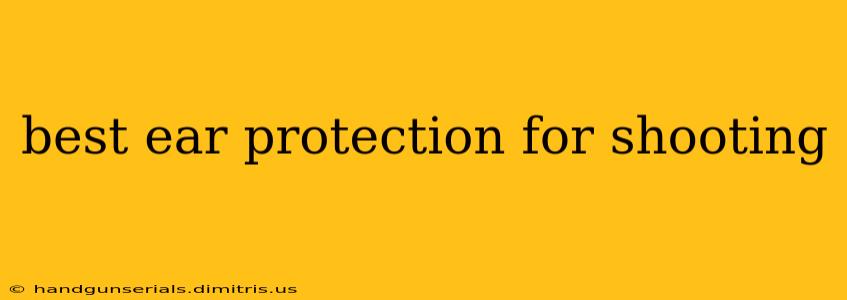Protecting your hearing on the shooting range is paramount. The intense sounds generated by firearms can cause irreversible hearing damage, even with a single exposure. This guide will explore various types of ear protection, helping you choose the best option for your needs and budget. We'll cover electronic hearing protection, passive hearing protection, and key factors to consider when making your selection.
Types of Ear Protection for Shooting
There are two main categories of ear protection: passive and electronic. Each offers distinct advantages and disadvantages.
1. Passive Hearing Protection
Passive hearing protection, such as earplugs and earmuffs, reduces noise levels through physical barriers. They're generally more affordable but don't offer the same situational awareness as electronic options.
a) Earplugs: These are inserted directly into the ear canal. They come in various materials, including foam, silicone, and custom-molded options.
- Foam Earplugs: Disposable and inexpensive, offering decent noise reduction but can be less comfortable for extended use.
- Silicone Earplugs: Reusable and more comfortable than foam, offering better noise reduction and a more secure fit.
- Custom-Molded Earplugs: Professionally fitted to your ear canal for superior comfort, noise reduction, and a secure fit. These are the most expensive option but offer the best protection.
b) Earmuffs: These cover the entire ear, creating a physical barrier against noise. They are available in various designs, materials, and noise reduction ratings (NRR). Higher NRR numbers indicate greater noise reduction.
- Over-the-Head Earmuffs: The most common type, offering good comfort and protection.
- Behind-the-Head Earmuffs: These offer a more secure fit and can be more comfortable for users who find over-the-head muffs cumbersome.
2. Electronic Hearing Protection
Electronic hearing protection amplifies ambient sounds while attenuating harmful noises exceeding a certain decibel level. This allows you to hear important commands and surrounding sounds while protecting your hearing from the loud bangs of gunfire.
These devices typically feature:
- Noise Reduction Ratings (NRR): Indicates the level of noise reduction provided. Higher NRR means better protection.
- Amplification Levels: The degree to which ambient sounds are amplified.
- Environmental Sound Enhancement: This technology helps filter and improve the clarity of surrounding sounds.
- Wireless Connectivity: Some models connect wirelessly to devices like smartphones.
Factors to Consider When Choosing Ear Protection
Choosing the right ear protection involves several key factors:
- Noise Reduction Rating (NRR): A higher NRR indicates greater noise reduction. However, the actual noise reduction achieved can vary depending on the fit and other factors.
- Comfort: You need comfortable ear protection that you'll actually wear. Discomfort leads to inconsistent use, defeating the purpose.
- Fit: A proper fit is crucial for effective noise reduction. Loose-fitting earplugs or earmuffs won't provide optimal protection.
- Cost: Ear protection ranges from inexpensive disposable plugs to high-end electronic muffs. Balance your budget with your needs.
- Environment: The shooting environment (indoor range vs. outdoor hunting) will influence your choice.
Recommended Ear Protection Options (Examples – No Links Provided)
While specific product recommendations are beyond the scope of this article to maintain objectivity, consider the following categories:
- Budget-friendly: Foam earplugs offer affordable protection for occasional shooting.
- Mid-range: Silicone earplugs or basic over-the-head earmuffs provide improved comfort and protection.
- High-end: Electronic hearing protection offers superior protection and situational awareness. Custom-molded earplugs are also a top choice for personalized comfort and maximum noise reduction.
Conclusion
Protecting your hearing is crucial for long-term health and enjoyment of shooting sports. By understanding the different types of ear protection and considering the factors discussed above, you can choose the best option to safeguard your hearing and ensure years of safe and enjoyable shooting experiences. Remember, consistent use is key. Don't risk your hearing – invest in quality ear protection.

